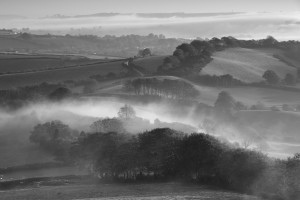by M R James

A View from a Hill
THERE’S MORE TO THIS THAN MEETS THE EYE ….
Here’s an uncanny tale.
An academic, Mr Fanshawe, is enjoying a summer visit to a new friend in the country, Squire Richards. He cycles the two miles from the station to the Squire’s residence, and after tea, the Squire suggests a walk in the surrounding park, so that the visitor can get his bearings for wider exploration during his stay. Mr Fanshawe borrows a pair of binoculars – old fashioned, heavy things, in a box with sharp corners on which he cuts himself as he struggles to open it.
The two friends walk to the top of a hill and the Squire points out places of interest. However, the landscape that Fanshawe sees through the binoculars is not the same landscape that he, or the Squire, sees with the naked eye. With the binoculars, Fanshawe sees a church tower in the distance, but the Squire insists there is no such thing; and he sees a wide expanse of grass at the top of a hill, where there is a gibbet with a body hanging from it – but the Squire assures him there’s nothing on top of “Gallows Hill” but a thick wood. They agree that Fanshawe will visit the hill the following morning to solve the mystery.
The next day, Fanshawe spends the morning looking through the records of the local Archaeological Society, which include contributions from a Mr Baxter – an eccentric local antiquarian who, it turns out, also fashioned the binoculars loaned by the Squire – and who had made a drawing of a tower which reminds Fanshawe of the tower he saw through the lenses the previous day. Later in the afternoon, he sets out on his exploration of the locality. He visits a couple of the local villages, looking into their churches, and ends up pushing his bicycle through what is indeed a thick wood at the top of Gallows Hill, puncturing his tyres in the process. His imagination conjures mysterious noises and figures in the wood, and, becoming frightened, he manages with difficulty to run with his cycle down the hill and eventually arrives back at the house.
The Squire employs a butler, Patten, who was apprehensive about the loan of the binoculars to Fanshawe. He tells that he was acquainted with Baxter, who was well known for roaming about the countryside at night, and collecting Roman artefacts and suchlike. There was an accident in which Baxter was injured in his kitchen, when a pot containing a boiling, dark and foul smelling liquid overturned and burned his leg. He was reported to have last been seen as if being dragged by unseen captives towards Gallows Hill, and later his broken-necked body was discovered there.
The following day, the binoculars are taken out again, but this time neither Fanshawe nor the Squire can see anything through them. The latter drops them on the terrace and from the barrel seeps a pool of inky black, odorous liquid.
So much for the bare bones of M R James’ story. What makes it such an uncanny read?
We have the idea of something which should have remained hidden but which has come to light; on the first evening, after the first exploration of the countryside with the glasses, nothing happens – except “the sensation, which invaded Fanshawe in the small hours that something had been let out which ought not to have been let out”.
And the atmosphere in the wood, which provokes Fanshawe to have “all the fancies one least likes”. He imagines “steps crackling over twigs behind me, indistinct people stepping behind trees in front of me … and even a hand laid on my shoulder. I pulled up very sharp at that and looked round, but there really was no branch or bush that could have done it. The, when I was just about at the middle of the plot, I was convinced that there was someone looking down on me from above – and not with any pleasant intent”. The sense of being stared at in the hostile landscape is brilliantly invoked in the BBC 2005 film adaptation of James’ story – written by Peter Harness – where the camera becomes the “someone” looking down and sweeping around Fanshawe to dizzying effect.
But perhaps the most uncanny of all in this tale is the suggestion that our eyes don’t always belong to us.
When a Dr Lawrence attends Baxter after his accident, he picks up a “little mask covered in black velvet” which he puts on, but Baxter tells him immediately to take off, saying “Do you want to look through a dead man’s eyes?” The doctor afterwards is sure that the mask was “made from the front of a skull” – this skull appears in Harness’s filmed version of the story in a terrifying nightmare that wakes Fanshawe in the small hours.
The binoculars show a different prospect to that seen with the naked eye – in the film version, this aspect of the story is given more prominence in that Fanshawe is seen sketching the “invisible” church and its tower whilst in the precinct. He views it through the lenses – at first with a delighted surprise at the experience, but then with horror when he is attacked by figures only fleetingly suggested in the shadows – and of course, not visible at all with the glasses.
